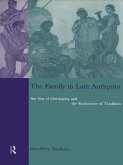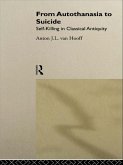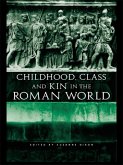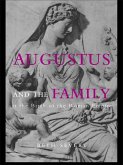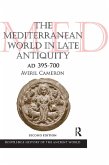The Family in Late Antiquity (eBook, PDF)
The Rise of Christianity and the Endurance of Tradition


Alle Infos zum eBook verschenken

The Family in Late Antiquity (eBook, PDF)
The Rise of Christianity and the Endurance of Tradition
- Format: PDF
- Merkliste
- Auf die Merkliste
- Bewerten Bewerten
- Teilen
- Produkt teilen
- Produkterinnerung
- Produkterinnerung

Hier können Sie sich einloggen

Bitte loggen Sie sich zunächst in Ihr Kundenkonto ein oder registrieren Sie sich bei bücher.de, um das eBook-Abo tolino select nutzen zu können.
The Family in Late Antiquity offers a challenging, well-argued and coherent study of the family in the late Roman world and the influence of the emerging Christian religion on its structure and value.
Before the Roman Empire's political disintegration in the west, enormous political, religious and cultural changes took place in the period of late antiquity. This book is the first comprehensive study of the family in the later Roman Empire, from approximately 300 AD to 550 AD. Geoffrey Nathan analyses the classical Roman family as well as early Christian notions of this most basic unit of…mehr
- Geräte: PC
- mit Kopierschutz
- eBook Hilfe
- Größe: 3.09MB
![The Family in Late Antiquity (eBook, ePUB) The Family in Late Antiquity (eBook, ePUB)]() Geoffrey NathanThe Family in Late Antiquity (eBook, ePUB)53,95 €
Geoffrey NathanThe Family in Late Antiquity (eBook, ePUB)53,95 €![Imperium Romanum (eBook, PDF) Imperium Romanum (eBook, PDF)]() Andrew LintottImperium Romanum (eBook, PDF)39,95 €
Andrew LintottImperium Romanum (eBook, PDF)39,95 €![From Autothanasia to Suicide (eBook, PDF) From Autothanasia to Suicide (eBook, PDF)]() Anton J. L. van HooffFrom Autothanasia to Suicide (eBook, PDF)45,95 €
Anton J. L. van HooffFrom Autothanasia to Suicide (eBook, PDF)45,95 €![Childhood, Class and Kin in the Roman World (eBook, PDF) Childhood, Class and Kin in the Roman World (eBook, PDF)]() Childhood, Class and Kin in the Roman World (eBook, PDF)51,95 €
Childhood, Class and Kin in the Roman World (eBook, PDF)51,95 €![Augustus and the Family at the Birth of the Roman Empire (eBook, PDF) Augustus and the Family at the Birth of the Roman Empire (eBook, PDF)]() Beth SeveryAugustus and the Family at the Birth of the Roman Empire (eBook, PDF)54,95 €
Beth SeveryAugustus and the Family at the Birth of the Roman Empire (eBook, PDF)54,95 €![The Mediterranean World in Late Antiquity (eBook, PDF) The Mediterranean World in Late Antiquity (eBook, PDF)]() Averil CameronThe Mediterranean World in Late Antiquity (eBook, PDF)46,95 €
Averil CameronThe Mediterranean World in Late Antiquity (eBook, PDF)46,95 €![A History of the Roman People (eBook, PDF) A History of the Roman People (eBook, PDF)]() Celia E. SchultzA History of the Roman People (eBook, PDF)112,95 €
Celia E. SchultzA History of the Roman People (eBook, PDF)112,95 €-
-
-
Before the Roman Empire's political disintegration in the west, enormous political, religious and cultural changes took place in the period of late antiquity. This book is the first comprehensive study of the family in the later Roman Empire, from approximately 300 AD to 550 AD. Geoffrey Nathan analyses the classical Roman family as well as early Christian notions of this most basic unit of social organisation. Using these models as a contextual backdrop, he then explores marriage, children, domestic servitude, and other familial institutions in late antiquity. He brings together a diverse collection of sources, transcending traditional studies that have centred on the legal record.
Dieser Download kann aus rechtlichen Gründen nur mit Rechnungsadresse in A, B, BG, CY, CZ, D, DK, EW, E, FIN, F, GR, HR, H, IRL, I, LT, L, LR, M, NL, PL, P, R, S, SLO, SK ausgeliefert werden.
- Produktdetails
- Verlag: Taylor & Francis eBooks
- Seitenzahl: 288
- Erscheinungstermin: 8. Januar 2002
- Englisch
- ISBN-13: 9781134706693
- Artikelnr.: 42669497
- Verlag: Taylor & Francis eBooks
- Seitenzahl: 288
- Erscheinungstermin: 8. Januar 2002
- Englisch
- ISBN-13: 9781134706693
- Artikelnr.: 42669497
- Herstellerkennzeichnung Die Herstellerinformationen sind derzeit nicht verfügbar.
Definitions and Models
Plan of Study
The Sources 2: Two Traditions The Roman Family
Marriage
Divorce Widowhood and Remarriage
Children
Half-Siblings
Step-Siblings and Other Children
Extended Family
Slaves and Freemen
Discipline
Conclusions
Christianity and the Family
Early Christian Thought
Early Evidence of the Family in Christianity 3: Constantine and the Confluence of Two Traditions Prologue: Legal Developments in the Third Century
Constantine and the New World Order
Constantine's Social Legislation
Introduction
The Married State
Children and Family
Slave Familia and Familiae
Conclusions 4: Marriage Introduction
Marriage
Augustine with Secular and Christian Thought
Contracting a Marriage: the Example of Honorius and Maria
Disconnects: Canon and Imperial Law
The Negative Example: Melania the Younger and Pinian
Problems in Marriage
Adultery
Domestic Violence
Conclusions 5: Alternatives to Marriage Divorce
Divorce and the Church
Divorce and the Law
Divorce in Practice
Widowhood and Remarriage
Church Encouragement
Choosing Widowhood
Remarriage
Legal Issues Surrounding Widowhood and Remarriage
Other States
Concubinage
Virginity
Conclusions 6: Children The Child
A New Status?
Making it to Adulthood
Children and Education
The Child in the Family
Fathers and their Children
Mothers and their Children
Domestic Help
Adult Children
Conclusions 7: The Extended Family Introduction
Two Extended families
Conclusions 8: Household Slaves Domestics
Christian Thought and Institutional Constructs
The Church as a Mediating Influence
The Church as a Supporter of Slavery
Legal Changes
Slaves in the Domus
Slaves as Victims
Slave Anger
Freedmen and Women
Conclusions 9: Final Thoughts Appendix Notes References
Definitions and Models
Plan of Study
The Sources 2: Two Traditions The Roman Family
Marriage
Divorce Widowhood and Remarriage
Children
Half-Siblings
Step-Siblings and Other Children
Extended Family
Slaves and Freemen
Discipline
Conclusions
Christianity and the Family
Early Christian Thought
Early Evidence of the Family in Christianity 3: Constantine and the Confluence of Two Traditions Prologue: Legal Developments in the Third Century
Constantine and the New World Order
Constantine's Social Legislation
Introduction
The Married State
Children and Family
Slave Familia and Familiae
Conclusions 4: Marriage Introduction
Marriage
Augustine with Secular and Christian Thought
Contracting a Marriage: the Example of Honorius and Maria
Disconnects: Canon and Imperial Law
The Negative Example: Melania the Younger and Pinian
Problems in Marriage
Adultery
Domestic Violence
Conclusions 5: Alternatives to Marriage Divorce
Divorce and the Church
Divorce and the Law
Divorce in Practice
Widowhood and Remarriage
Church Encouragement
Choosing Widowhood
Remarriage
Legal Issues Surrounding Widowhood and Remarriage
Other States
Concubinage
Virginity
Conclusions 6: Children The Child
A New Status?
Making it to Adulthood
Children and Education
The Child in the Family
Fathers and their Children
Mothers and their Children
Domestic Help
Adult Children
Conclusions 7: The Extended Family Introduction
Two Extended families
Conclusions 8: Household Slaves Domestics
Christian Thought and Institutional Constructs
The Church as a Mediating Influence
The Church as a Supporter of Slavery
Legal Changes
Slaves in the Domus
Slaves as Victims
Slave Anger
Freedmen and Women
Conclusions 9: Final Thoughts Appendix Notes References

